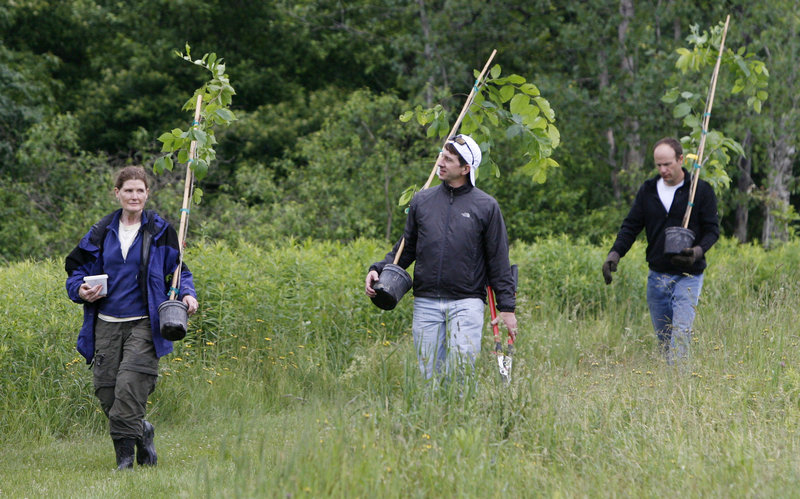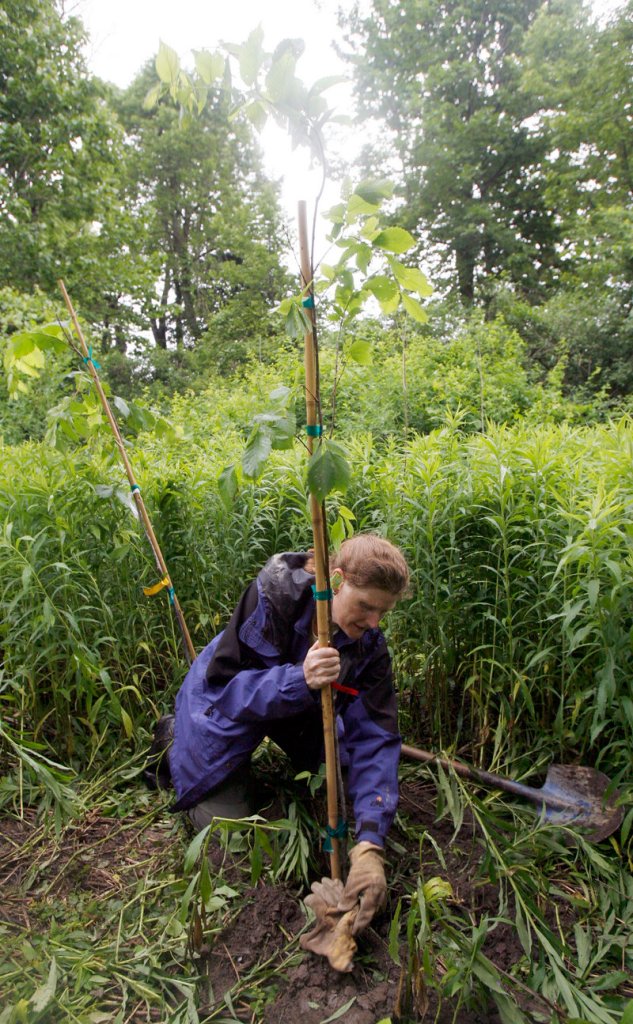SHELBURNE, Vt. – Seventy-year-old Judy Peabody walked a quarter-mile through a meadow, down a steep incline into the woods, through a densely overgrown trail and into a field 4 feet deep in goldenrod Thursday — just to plant a tree.
Not just any tree. A disease-resistant American elm tree.
Peabody, a volunteer whose botany experience usually extends only to her own garden, was happy to do it.
She wasn’t alone: As part of a project by the U.S. Forest Service and The Nature Conservancy, about a dozen people tramped through the woods to plant 30 skinny “baby” elms in the LaPlatte River floodplain.
The planting is part of the first attempt at restoring American elms into natural areas east of the Appalachian mountains. The hope is that the effort will fuel a renaissance of the beloved tree that was decimated by disease in the 1970s.
“We’ve had problems with the elms,” Peabody said. “This is a good thing we’re doing.”
The elm, whose towering size and vase-like shape made it a favorite of urban foresters, fell victim to Dutch elm disease beginning in the 1950s. The fungus eventually killed 100 million, stripping once-canopied streets and parks bare.
The new Forest Service effort has centered in Ohio, Wisconsin, Minnesota and Iowa, but now the push is on to reintroduce the trees into natural areas of the Northeast, under the theory that success there will lead to seed spreading that will help return them to prominence.
For now, the goal is to restore the American elm to forested landscapes, using cloned sections taken from six trees identified over years of research as having the tolerance to withstand the disease, said Jim Slavieck, a Forest Service research biologist who is the project leader.
“The trees are not resistant, in that they will come down with Dutch elm disease. But they’re able to survive it, whereas most trees die from the disease,” he said.
The trees planted Thursday were propagated in a Forest Service nursery in Delaware, Ohio. If they thrive, organizers hope to expand the plantings to New Hampshire, Massachusetts and Connecticut, Slavieck said.
The saplings were planted in a half-acre field and tied to stakes. They stand about 6 feet tall now and are expected to grow 4 to 8 feet a year because of the nutrient-rich riverside location.
The program isn’t without its critics.
Yvonne Spalthoff, assistant director of the Elm Research Institute in Keene, N.H., said her group has concerns about the protocols used to develop the disease-resistant varieties of elm being used in the project.
Her group has sought answers from the Forest Service program about how the trees from which the saplings were cloned were determined to be disease-resistant, and whether the young trees will be adequately tracked for survival rates, she said.
The Institute is a nonprofit established in 1967 to raise money for Dutch elm disease research that has helped fund the development of the disease-resistant American Liberty Elm variety.
Slavieck, in turn, said that two of the strains had 96 percent survival rates over a seven-year period after being injected with massive amounts of Dutch elm fungus in laboratory tests.
Send questions/comments to the editors.




Success. Please wait for the page to reload. If the page does not reload within 5 seconds, please refresh the page.
Enter your email and password to access comments.
Hi, to comment on stories you must . This profile is in addition to your subscription and website login.
Already have a commenting profile? .
Invalid username/password.
Please check your email to confirm and complete your registration.
Only subscribers are eligible to post comments. Please subscribe or login first for digital access. Here’s why.
Use the form below to reset your password. When you've submitted your account email, we will send an email with a reset code.